Since almost the dawn of civilization, people have claimed there are no such thing as new ideas. I’ve never been one to buy that, seeing as we’ve come so far compared to where we were in the past, but it’s still something people like to trade around. However, looking at the stories we tell and the repetition of plots and archetypes, it’s easy to understand why some would disagree. We like familiarity, we like to see something that feels comfortable to us, and thus newer ideas often sit as niche for a while. The other ideas, the old well-tread stories, are easier to push forward and thus easier to notice. Generally, they feature something timeless that doesn’t require a lot of change to feel contemporary.
But even those are usually different as time goes on, we’re always adding to what existed before. Sometimes, those changes even happen without the fans wanting them to happen. One of the loudest criticisms of the Twilight books is what they did to vampires and werewolves. Fans of the horror genres felt that creatures which could have been “cool” and threatening were now fairly pretty instead. Unfortunately for those people, it wasn’t really Twilight’s fault and that ship sailed a long time ago.

But not very long ago I mentioned that the same was happening to a more unexpected creature. Once upon a time, zombies were a fairly scary thing which were seen as this ultimate form of “the other”. But as time has gone on they’ve lost a bit of their edge. They now feature in comedies, dramas, action movies, and even…romances. With the production of things like Warm Bodies and iZombie, we’ve managed to find ourselves seeing zombies as something that you could love and be attracted to. And for whatever you may think of the over-saturation of the market – that’s a relatively new idea that in 36 years has taken us from this:
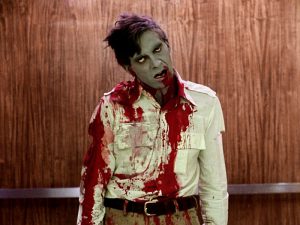
To this:

So, the question becomes: How exactly did we go from head-shots to money-shots?
Unnatural Progression
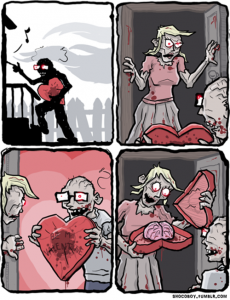
To really understand how you could get to something like this, you have to think about how the human mind works through mythology. Long ago, prehistoric in most circles, the majority of the human race were what we would refer to as animist. Animism, the belief that all things have souls, meant that we would often project an identity onto a force or an object even if we didn’t necessarily believe them to be a person. One example from ancient Egypt is the sun god Aten, not the Ra we’re most familiar with, who was simply a golden disk known to represent the sun. This entity really isn’t really a part of the stories most commonly associated with Egyptian sun gods and was generally seen as an extension of Ra.
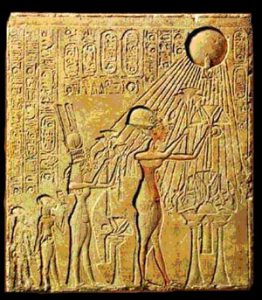
And that’s how a lot of mythology tends to begin, an impossible to understand force being deified and given an icon that can be worshiped in their place. You couldn’t reach out and touch the sun, but you could carry a golden disk. You couldn’t see the wind, but you could believe it to be a living entity that could hear you. You couldn’t reason with a lightning bolt, but you could potentially pray to the thunderbird which guided it. Though, frankly, reasoning with thunder gods rarely worked out in the past (unless you were an attractive woman and Zeus noticed you, then your problem was with Hera).
But humans can’t stop there, we like more than simply having a force to deal with, we want them to have personalities and wills. We want them to have personifications. Aten was rarely the most successful of sun gods in ancient Egypt, the idea of a golden disk was somewhat more accurate but less personable than the other gods that could step in its place. And, seeing as the Pharaohs at the time proclaimed themselves to be descended from gods – it didn’t make sense to be descended from a frisbee. So Aten, Horus, Ra, Atum, and many others were all fused together into a single entity with many different avatars. And that form, despite the strange mash up, was generally depicted distinctly anthropomorphic.
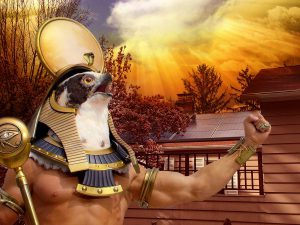
This is generally the way of mythology. Something that we don’t necessarily understand will become mystified, then personified, then manipulated. The same is true of creatures of folklore that are still used even today. Problems such as disease, fear of death, and the bizarre nature of corpses left a distinct impression on us that soon required a personification. Even sleep paralysis, a scary but somewhat natural event, required something to be responsible for it, resulting in the introduction of the incubus.

But as time went on, the incubus and the succubus needed to be something more intriguing to people, much as the Egyptian gods needed to seem human. They needed to do more than simply sit on your chest as invisible invaders. Thought up in a culture of shame and repression, they could be blamed for all of your sinful thoughts and dreams. Oh sure, something has invaded your bed, invaded your dreams, and even invaded your lusty thoughts. And, since it would be strange to lust after an evil little imp, it had to have been an attractive demon. If something’s got to pin you in your bed, it may as well look like this.

For most mythological creatures that’s the natural progression. First the deification, then the personification, and eventually the objectification. It’s not so much that humans are trying to be perverted, but as we become more familiar with things we become less concerned and more “interested”. These creatures, at one point, represented something truly horrifying to us. But time and some rationality eventually taught us that they never really posed a real threat to us. After all, if the zombie apocalypse was going to happen, it probably would have happened by now. It’s impossible for these things not to change over time as we realize they can’t possibly be as dangerous as we once believed.
The vampire, in particular, started in days when humans would be exposed to corpses and realize that they were bizarre looking to say the least. The hair and nails would appear to have continued growing, as if the body were still alive, and given diseases like the plague seemed to take people in the night – people made connections. Throughout history the strange appearance of the deceased and the dangers of the night crossed into this beautiful little coincidence that scared the shit out of people. Ancient cultures around the world had some variation of this concept, though in no way as severe as Europe in the middle ages.
Though various creatures of the night had been part of folklore for centuries, it wasn’t until the 18th century that Europe completely lost their shit about it. All across the continent there was a fear that the undead were coming to kill us all, and many people went so far as to impale bodies as a means of preemptively stopping them from rising. One would think that these were the actions of crazy people, but seen from their perspective it made all the sense in the world. Corpses were always creepy to begin with, but an event centuries prior had made Europeans absolutely horrified of them – The Black Death. In fact, some accounts say that the plague was even introduced to Europe as the Mongols took their plague ridden corpses and launched them over city walls. Because if one thing truly defined Genghis Khan and his people, it was ensuring you knew exactly how they felt about you.
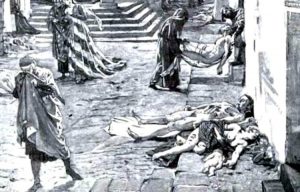
As the city began to be bombarded with corpses and people began to fall ill out of nowhere – how could you not suspect the bodies? The field of medicine wasn’t particularly well developed at the time, but the correlation was hard to miss. And, seeing as germs wouldn’t be proven to exist for another 4 and a half centuries, clearly the bodies had to be doing something at night while no one was looking. This happened in Crimea, to the Eastern most part of Europe, and the general fear of the dead spread pretty fast throughout that region. It lingered there for a time before spreading to the rest of the continent and at that point there was really no going back.
The thing was, like the recent trends with zombies, vampires went from absolutely terrifying in the 18th century to somewhat acceptable in the 19th century. So long as it remained in Slavic countries and not entirely in the mainstream it was still fairly terrifying. But once books like The Vampyre and Dracula were getting published it was only a matter of time. In fact, by the time Dracula was published the familiarity with the concept had somehow taken vampires to a strange new level. No more than a century prior, the idea of vampires was reason enough to stab your grandmother to make sure she was still dead. Now, seeing as none of those corpses had actually been seen rising from their graves, it was dangerously sexy instead.
Part of it is also the attraction of controlled danger. Danger is exciting and will get your heart racing by default. The fight or flight response is hard to suppress. But something about the human condition that we all have to accept from time-to-time is that if it excites us but doesn’t necessarily scare us – we’re going to be conflicted about it. Too many people know that an armed stranger can get you going so long as you have a safety word. And, due to never showing a real threat, certain creatures have long ago entered that domain.
For some of them it’s almost inescapable. The vampire, once it was mainstream, only had a short time before it went all the way. Stories of corrupting influences, cross-pollination with succubi, and the torrid history of blood-soaked Eastern European nobles resulted in an inevitable conclusion. Say what you will of the Countess Bathory, one of the major influences of modern vampire mythos, but we know two things about her.
- She was incredibly violent and literally soaked herself in the blood of commoners.
- She looked damn good doing it.

And, morbid as that may be, it’s part of the culture now and hard to separate from the rest of the lore. We’ve become familiarized with the concept, we’ve Rule 34’d it, and we can’t unsee that. The truth is that it’s happening to all of the old staples now. Vampires and werewolves were the first to go as they became the backbone of a genre, but soon after we were seeing sexy ghosts and sexy zombies. And, now that it’s started, it’s unlikely we’ll ever see it fully go away. This is part of human nature. We’re not only unafraid of these things, we’ve turned them into slutty costumes.
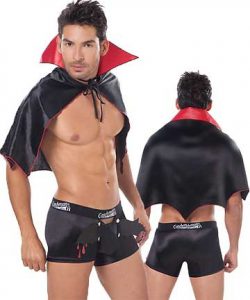
For some fans of horror this is a terrible loss as it means the loss of a genre to them. What was once horrifying has now started to lose it’s bite. And, while the work of things like The Walking Dead are still pulling their weight as far as keeping zombies scary, it’s only a matter of time before it starts to shift harder in the other direction. The market has become saturated, the creatures are becoming familiar, and once productions like that have time to fade from memory, we’ll start seeing more unusual depictions.
It’s not really the end of the genre, however, because terrifying things are always available. The world is full of niche stories that never quite got the exposure they deserved. Maybe now we’re slowly losing the idea of the scary vampire, the scary werewolf, and the scary zombie. But there are things out there which can someday take their place, work their way into the mainstream, and start to terrify a whole new generation. And, fortunately for those fans of wetting themselves…
It’s going to be hard to find some of these attractive.
(I write novels! I don’t make my vampires particularly sexy, but I’m sure if they ever hit a screen, the actors will have tumblr fans. Probably twitter fans too.)







